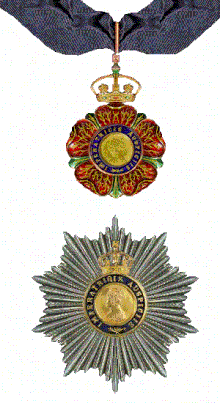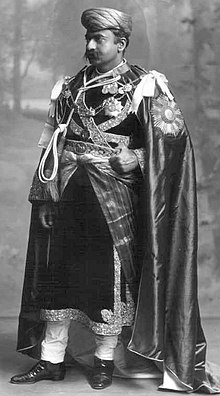Order of the Indian Empire
The Most Eminent Order of the Indian Empire is a British order of knights founded by Queen Victoria in 1877 .
The order has not been awarded since independence from India and Pakistan in 1947, but it still exists. After the death of the last Knight Commander, the Maharaja of Dhrangadhra , in August 2010, Queen Elizabeth II is the last living member as sovereign of the order. The motto of the order is Imperatricis auspiciis ( Latin for under the auspices of the empress ).
The order was established to honor British and local officials. It was created as a less exclusive award compared to the Order of the Star of India and also awarded much more often.
Order structure
The order is headed by the sovereign of the order (the respective British monarch) and the order-grandmaster (by virtue of his office always the viceroy of India ).
When it was founded in 1877, the order had only one class, namely that of a Companion (CIE). On February 15, 1887 the higher class of a Knight Commander (KCIE), on June 21, 1887 that of a Knight Grand Commander (GCIE) was added. Since then the order has the following three classes:
- Knight Grand Commander (GCIE)
- Knight Commander (KCIE)
- Companion (CIE)
Deviating from the usual British designations, the highest class was not referred to as the Knight Grand Cross in order to improve the acceptance of the order among non-Christian Indians.
Unlike in the other orders, female knights were not referred to as "lady", but, like the men, as "knight".
The statute limited the number of appointments to 20 per year. By 1895 around 450 people had been awarded, of whom a third were Indian, while from 1895 to 1947 a further 600 appointments were made, the greater number of whom were Indian.
Ceremonial clothing and regalia
On important occasions, such as the coronation of British monarchs , the members of the Order wore their own ceremonial attire, which was dependent on the class:
- The cloak was only worn by the Knights Grand Commanders. It was made of dark blue satin framed with white silk. The breast star (see below) was worn on the left.
- The collane , also only worn by Knights Grand Commanders, was made of gold. Their limbs were formed alternately as golden elephants, Indian roses and peacocks.
Simpler insignia were used on less important occasions:
- The breast star was only worn by the Knights Grand Commanders and the Knights Commanders on the left chest. It had ten rays. For the Knights Grand Commanders star, these were alternately made of gold and silver, for the Knights Commanders they were exclusively silver. In the center of the star was a picture of Queen Victoria surrounded by a dark blue ribbon with the motto of the order, which in turn was crowned.
- The medal was the only one to be worn by all members of the order. It was worn on a dark blue ribbon with white edges. Knights Grand Commanders wore the badge on a sash that was carried over the right shoulder to the left hip. Knight Commanders and Companions wore it on the ribbon as a neck medal . The medal itself was a five-petalled crowned red flower with the image of Empress Victoria in the middle, surrounded by the ribbon with the motto of the order described above.
In contrast to the majority of British knightly orders, the insignia deliberately did not use the Christian symbol of the cross in order to facilitate the acceptance of the order among Indian non-Christians.
Hierarchy and privileges
The members of the order had a position in the protocol Aryan ranking in the UK ( Order of Precedence ), a list in which the registered persons are classified according to their nominal significance and plays an important role in ceremonial events. Wives of male members were also accepted there; so are the sons, daughters and daughters-in-law of Knights Grand Commander and Knights Commander. In contrast, relatives of a female member were not included in the list.
With the elevation to Knight Grand Commander and Knights Commander , the knighthood and thus the elevation to the personal nobility was connected for subjects of the sovereign and with it the authority to use the predicate " Sir " before their first name; female Knights Grand Commander and the Knights Commander as well as the wives of Knights Grand Commander and Knights Commander were allowed to use the predicate "Lady" in front of their names; no comparable privilege existed for the husbands of the female knights. Instead of these predicates, many knights of the order carried the predicates associated with their higher nobility titles. If foreigners were accepted into the order who were not subjects of the sovereign, the acceptance was on an honorary basis (as Honorary Knight Grand Commander or Honorary Knight Commander ) and was not associated with a nobility.
All members of the order were entitled to add the letters GCIE , KCIE or CIE as post-nominations, depending on their class .
Knights Grand Commanders were authorized to include shield holders in their crests . They were also allowed to include a circlet showing the order's motto and an image of the collar in their coat of arms. Knights Commanders and Companions were only allowed to show the circlet in their coat of arms, but not the chain of the order.
Well-known medal bearers
- Arthur, Duke of Connaught and Strathearn , GCIE
- Edward Frederick Lindley Wood, 1st Earl of Halifax , GCIE
- Louis Mountbatten, 1st Earl Mountbatten of Burma , GCIE
- Frederick Roberts, 1st Earl Roberts , GCIE
- Sir Ganga Singh , 21st Maharajah of Bikaner , GCIE
- Archibald Wavell, 1st Earl Wavell , GCIE
- Ahmad al-Jabir al-Sabah , KCIE
- George Abraham Grierson , KCIE
- Douglas Haig, 1st Earl Haig , KCIE
- Sven Hedin , KCIE
- Taimur ibn Faisal , KCIE
- Edwin Lutyens , KCIE
- George Macartney , KCIE
- Ugyen Wangchuck , KCIE
- William Thomas Blanford , CIE
- Abdul Karim , CIE
- Jagadish Chandra Bose , CIE
- Bankim Chandra Chatterjee , CIE
- Jadunath Sarkar , CIE
Literature and web links
- William Arthur Shaw: The Knights of England. Volume 1, Sherratt and Hughes, London 1906, pp. Xxxi f.
Individual evidence
- ^ The London Gazette : 25673, 786 , February 15, 1887.
- ^ The London Gazette : 25773, 218 , January 5, 1888.
- ^ Russell Malloch in: The Gazette Official Public Record



